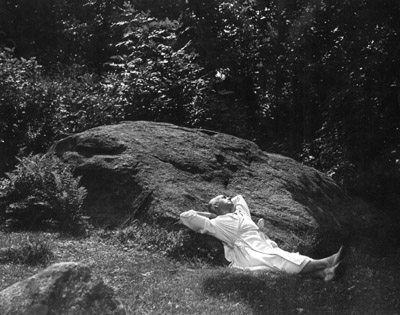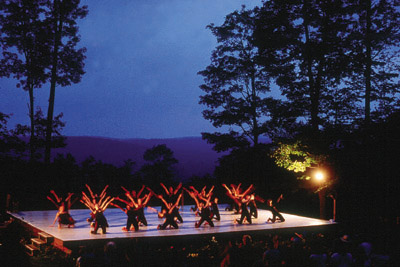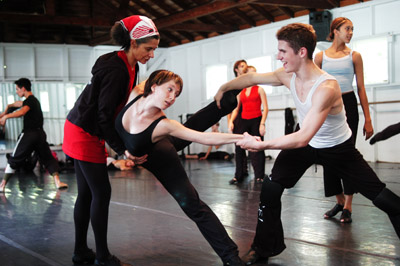Jacob's Pillow
From Wikipedia, the free encyclopedia.
Jacob’s Pillow is a National Historic Landmark located in the town of Becket, Massachusetts, in the Berkshires. As a home for dance in the United States, it encompasses an internationally acclaimed summer dance Festival (the first and longest-running in the United States), a professional School, rare and extensive Archives, an Intern Program, and year-round Community Programs.
The Ted Shawn Theatre. Photo: Jessica Wickham
Contents |
History
The Pillow, as it is affectionately known, was first settled in 1790 by the Carter family as a mountaintop farm at the crest of a twisting, climbing stagecoach road between Boston and Albany. Local folk viewing the zigzagging road from the bottom of the hill thought it resembled the rungs of a ladder, so these biblically-minded New Englanders named it “Jacob’s Ladder.” Boulders dotted the farm pastures, among them a curiously-shaped one located behind the Carter’s farmhouse. The family knew well the story from the Book of Genesis, which tells of Jacob laying his head upon a rock and dreaming of a ladder to heaven. Given the rock “pillow,” and the farm’s proximity to “Jacob’s Ladder,” the farm from then on was known as “Jacob’s Pillow.”
In 1931, modern dance pioneer Ted Shawn bought the farm as a retreat. At the time, Shawn and his wife, Ruth St. Denis, were America’s leading dance couple. Their Denishawn Company had popularized a revolutionary dance form rooted in theatrical and multi-cultural traditions rather than those of European ballet. Their trailblazing work and cross-country tours paved the way for the next generation of legendary dance pioneers: Martha Graham, Charles Weidman, Doris Humphrey, and Jack Cole were all Denishawn members. But Shawn and St. Denis had recently separated, personally and professionally, and in the fall of 1931, Shawn conducted the last rehearsals of the Denishawn era at Jacob’s Pillow.
Ted Shawn laying his head upon the Jacob’s Pillow Rock. Photo: Eric M. Sanford.
Shawn had long harbored a dream of legitimizing dance in America as an honorable career for men. In 1933, he recruited eight men, including Denishawn dancer Barton Mumaw and several physical education students from Springfield College for his new company. The tall and burly Shawn and his athletic dancers were intent on challenging the image of men in dance; they forged a new, boldly muscular style. In their “off-time,” they constructed buildings still used today at Jacob’s Pillow.
In July 1933, Shawn and his Men Dancers started giving public “Tea Lecture Demonstrations” to promote their work—and to pay the grocer. The first audience of 45 curiosity-seekers expanded weekly so that by summer’s end, people were being turned away at the door. During a period Shawn termed “seven magic years,” Shawn and his Men Dancers toured throughout the United States and to Canada, Cuba, and England, performing more than 1,250 times in 750 cities, and continued the summer “Tea Lecture Demonstrations” at the Pillow. Radical changes were necessitated by the Selective Service Act of 1939, although Shawn also justifiably believed that his artistic statement had been made and that it was time to end his successful crusade. In May 1940, The Men Dancers disbanded and joined the armed forces.
Deep in debt, Shawn proposed selling Jacob’s Pillow to Mary Washington Ball, a dance teacher who leased the property and produced the Berkshire Hills Dance Festival on site in 1940. Shawn credited Miss Ball for beginning the diverse programming that was forever after the Pillow’s hallmark, but the summer was a financial disaster. Shawn leased the Pillow again in 1941, this time to British ballet stars Alicia Markova and Anton Dolin. Their International Dance Festival was so successful that local supporters formed the Jacob’s Pillow Dance Festival Committee, raised $50,000 to buy the property and to build a theater (performances had been held in the barn studio), and made Shawn director. Despite wartime hardships, such as gasoline and tire rationing, audiences climbed the hill on foot and horseback to attend a wide array of programs: ballet, modern dance, mime, ballroom dance, and folk dance of many cultures.
On July 9, 1942, the Ted Shawn Theatre, the first theater in the United States designed specifically for dance, opened its doors. Architect Joseph Franz, who also built The Music Shed at Tanglewood, had agreed with Shawn that the theater exterior must harmonize with the existing farmhouse and barns. Franz also hand cut the weathervane atop the theater, which depicts Barton Mumaw, Shawn’s leading dancer. Inside the theater on either side of the stage are life-size portraits of Shawn in his Hopi Indian Eagle Dance and Ruth St. Denis as Kwannon—the Japanese Goddess of Mercy, painted during the Denishawn era by Albert Herter.
Other than a year sabbatical for an Australian tour in 1947, Shawn remained at the helm of the Pillow until his death at the age of 80 in 1972. For a time the survival of Jacob’s Pillow seemed uncertain. Shawn’s designated successor, John Christian, was unable to serve more than one year (1972) due to illness. Next was dance critic Walter Terry (1973), but a huge deficit sent the Pillow’s Board of Directors searching again, and in the interim Charles Reinhart took on the Pillow in addition to the American Dance Festival (1974). A measure of stability came with the appointment of Norman Walker (1975-79), who revamped and upgraded the Pillow’s educational and presentational standards.
Liz Thompson (1980-90) initiated an artistic resurgence by welcoming new artists and audiences. Her innovations, such as the popular Inside/Out presentations and open access to the grounds and studios, are today an integral part of the Pillow’s personality, and Thompson was also the catalyst for the construction of the Doris Duke Studio Theatre. Samuel A. Miller, who had worked in partnership with Thompson since 1986, followed (1990- 94) with the sorely needed renovation and enlargement of the Ted Shawn Theatre and the installation of Blake’s Barn. From 1995 through 1997, Sali Ann Kriegsman led the Pillow through a difficult period, eliminating a potentially disastrous $4.8 million debt, orchestrating a range of new projects, and ending her successful tenure with a celebration of the 65th anniversary season. The Board then launched an extensive nationwide search and in 1998 selected Ella Baff to guide Jacob’s Pillow into the 21st century.
Ella Baff’s record-breaking seasons have confirmed that her adventurous ideas and wide-ranging knowledge of the field are perfectly at home at the Pillow. She is now leading the organization in new directions, while honoring the traditions that have made the Pillow a unique institution for more than seven decades: to create, present and preserve an unparalleled variety of dance forms, to educate artists and the community, and to engage and build audiences—a diversity unique among international festivals.
In 2003, Jacob’s Pillow was declared a National Historic Landmark by the federal government as “an exceptional cultural venue that holds value for all Americans.” It is the first and only dance entity in the U.S. to achieve this honor. The Pillow looks forward to celebrating its 75th anniversary in 2007, and has launched its first endowment campaign, The Fund for Jacob’s Pillow, to help ensure its eminence and longevity for others to enjoy in years to come.
The Festival
The Pillow presents international dance in all forms, styles, and traditions, and approximately 200 free events each season, including performances, lectures, tours, film showings, exhibits, and talks with artists from all over the world, culminating in approximately 80,000 visitor experiences annually. The Jacob’s Pillow mission is to support dance creation, presentation, education, and preservation; and to engage and deepen public appreciation and support for dance.
A performance on the Inside/Out Stage. Photo: Skip Brown
Pillow Founder Ted Shawn was instrumental in beginning in the careers of Martha Graham and Jack Cole, and the Pillow has continued this mentoring role by providing opportunities to young artists such as Alvin Ailey, José Limón, and Mark Morris. Companies such as Dance Theatre of Harlem and the Parsons Dance Company have been seen at the Pillow for the first time anywhere, and international groups such as The Royal Danish Ballet and Nederlands Dans Theatre have made their U.S. debuts here. World premieres have been commissioned from masters such as Merce Cunningham and Paul Taylor, and legendary artists such as Margot Fonteyn and Mikhail Baryshnikov have been showcased in works.
Performances at Jacob’s Pillow take place on three stages. The Ted Shawn Theatre, designed by Joseph Franz in 1942 as the first theater in America created specifically for dance, has a capacity of 620 reserved seats. The Doris Duke Studio Theatre, built in 1990 as a flexible, experimental space, has 220 general admission seats. Talks by Pillow Scholars-in-Residence take place before every performance in these two theaters. Additionally, Post-Show Talks happen in the Ted Shawn Theatre on Thursdays and in the Doris Duke Studio Theatre on Fridays, giving audiences an opportunity to engage with artists in moderated Q&A sessions.
The third stage is Inside/Out, which presents free performances of established and emerging artists from all over the world in an informal, outdoor venue set against a panoramic vista of the Berkshire hills. Wednesdays preview the Doris Duke Studio Theatre artists, Thursdays and Fridays feature up-and-coming artists, and Saturdays showcase the aspiring dancers of The School at Jacob’s Pillow. Each performance at Inside/Out concludes with a Q&A session with the artists.
Another facet of Jacob’s Pillow’s ongoing efforts to make dance accessible to all is the PillowTalk series, which provide an opportunity to learn more about the art of dance and artists performing each week through intimate panel discussions, interviews, film screenings, and book signings. Exhibits are free and open to the general public, as are The Archives, which offer the opportunity to view a video, browse through a book, access the Pillow’s computer catalog, or peruse permanent collections of Pillow programs and photographs. Free historical walking tours are available to the public weekly.
The School and Year-Round Community Programs
Each year, hundreds of dancers audition in eleven cities in the U.S. and around the world for The School at Jacob’s Pillow. Each dancer is aware that acceptance leads to access to a prestigious international artist faculty and an incomparable learning environment.
Students of The School at Jacob’s Pillow in rehearsal. Photo: Mike van Sleen
The School’s conservatory-style curriculum includes five programs: Ballet, Cultural Traditions, Contemporary Traditions, Jazz, and Choreographers’ Lab. The dancers’ schedule is rigorous: six days each week with four professional-level studio classes each day, coaching sessions, weekly performances for the public, master classes with Festival artists, talks led by Scholars-in-Residence, study assignments in the Pillow’s rare and extensive Archives, and attendance at all Festival performances and events. The Pillow experience requires a work ethic equal to that of professional dancers worldwide, and offers a breadth of career opportunities. World-renowned alumni attest that their artistic horizons, contacts in the professional community, and personal and artistic growth were transformed as a result of studying at the Pillow.
The success of The School at Jacob’s Pillow is due in large part to its extraordinary faculty. Artists of remarkable accomplishment, they are in demand across the globe as master teachers, choreographers, directors, and coaches. Alumni of The School perform on Broadway, in films, and with leading international dance companies, including American Ballet Theatre, Hubbard Street Dance Chicago, Dutch National Ballet, and in the Oscar-winning film Chicago. Visitors to Jacob’s Pillow are free to observe our artist-faculty and international students at work in the Ben and Estelle Sommers Studio.
Jacob's Pillow is active year-round, building participation in the arts. Vibrant, enriching, and educational Community Dance Programs annually reach more than 3,000 Berkshire children, students, educators, special needs groups, continuing education adult learners, and dancers of all ages and levels of experience. The programs take place at the Pillow, in schools and other settings, and are designed to meaningfully connect a wide range of participants with the intellectual, emotional, inspirational, as well as physical, world of dance.
Each year, Berkshire County students and teachers choreograph dances to explore topics required for mastery in academic classes, including science, math, history, and communication. The innovative Jacob’s Pillow Curriculum in Motion® program, featured as an educational model on National Public Radio, places Pillow artists in the classroom to develop and teach curricula that meet state and national arts and academic standards. The results are inspiring and persuasive: students demonstrate higher test scores, improved critical thinking, and positive social interaction. Annual Summer Dance Institutes bring together school administrators, teachers, and artists to examine effective teaching strategies that further promote student achievement in academics and the arts.
The Pillow partners with community organizations throughout Berkshire County to provide access to dance activities and learning from Festival artists and staff. A year-round partnership with the Railroad Street Youth Project promotes teen leadership and community involvement through the development of choreographic work. During the Festival, the Pillow partners with America’s Camp, for children who lost parents in the 9/11 tragedy; Berkshire Institute for Lifelong Learning; Elderhostel Programs; and the Boston Symphony Orchestra’s Days In The Arts and Shakespeare & Co. Arts for All programs. The Pillow provides these groups with dance classes, guided tours, performance and School observation opportunities, and access to artists and staff.
The public is invited to join Pillow interns, students, and staff on weekday mornings for Pilates, modern, and ballet, and each Sunday for master classes led by Doris Duke Studio Theatre artists. Thursday afternoons in July, in collaboration with the Becket Arts Center, the Pillow offers a special class for children accompanied by an adult.
The Pillow also offers one of the most respected training programs in the country for arts administration and technical theater through its Intern Program. Thirty interns from around the world, and from such distinguished institutions as Harvard University, Stanford University, Simon’s Rock College, and international cultural agencies, receive on-the-job training with Festival artists and staff. Former interns are now accomplished professionals at prestigious arts organizations worldwide, including eight on the Pillow’s year-round and seasonal staff.
Quotes
“I believe that dance communicates man’s deepest, highest and most truly spiritual thoughts and emotions far better than words, spoken or written.” – Ted Shawn, Jacob’s Pillow Founder
“There is no place quite like Jacob’s Pillow.” – Mikhail Baryshnikov
“Dance fans love to revel in the festival’s history, because its story is a good one…Amid the illustrious names, the Pillow itself is always one of the chief attractions. It’s simply lovely to be there.” – The New York Times
“Architecture can give a permanent presence and identity to dance. To think of the Kirov Ballet is to picture its home, St. Petersburg’s Maryinsky Theatre, a pastel rococo confection. The Paris Opera Ballet is indelibly linked with the over-the-top Second Empire Opera Garnier. American dance is short on such landmarks. The most prominent exception is not a grand opera house, but the barns that make up Jacob’s Pillow—both authentic barns and buildings designed in the same spirit of New England frugality and simplicity.” – The Boston Globe





